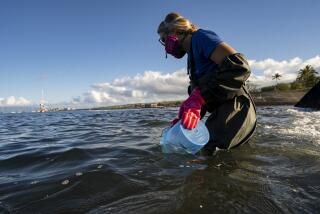Voyage to study effects of ocean acidification off U.S. West Coast
A team of scientists is setting out on a research expedition along the U.S. West Coast to study ocean acidification, the greenhouse gas-driven change in the chemistry of seawater that has been called climate change’s “evil twin.”
Chemists and biologists from the National Oceanic and Atmospheric Administration will board the survey ship Fairweather next week, sailing from Canada to Mexico to collect samples of water, algae and plankton, officials said Thursday. The goal of the monthlong voyage is to better understand how marine ecosystems are responding to water that is becoming more acidic as a result of the buildup of carbon dioxide in the atmosphere.
“We will for the first time not only study the chemistry of acidification but also study at the same time the biological impacts,” Richard Feely, an oceanographer with NOAA’s Pacific Marine Environmental Research Laboratory, told reporters in a telephone briefing.
Oceans have absorbed about 25% of the greenhouse gases that have accumulated in the atmosphere from the burning of fossil fuels, buffering some of the effects of climate change, Feely said. But that comes at a great cost to marine life because when carbon dioxide dissolves in seawater, it lowers the water’s pH. The gradual change in chemistry poses a particular threat to shellfish such as oysters and clams that require alkaline water to build their protective shells.
The research expedition could shed light on whether acidification is harming pteropods, marine snails that are especially sensitive to changing acidity and are a key food source for fish, birds and whales. Scientists also want to know whether acidification is making harmful algae blooms more toxic to marine life. Increased toxicity has been shown in laboratory experiments but not observed the field.
Another focus will be how much of an additional threat ocean acidification poses to marine life along the California Current, which stretches from British Columbia to Baja California.
A survey of the West Coast by the federal agency in 2007 identified the current as a hot spot for ocean acidification because of its naturally carbon dioxide-rich water, which comes to shore from cold, nutrient-rich water that wells up from the deep ocean. Now, researchers hope to gauge how much those natural conditions are interacting with surface waters that have higher levels of carbon dioxide from the atmosphere.
Initial results from the expedition will be presented during stops in San Francisco and San Diego, officials said, with complete findings published by next year. The information could be used to help the West Coast’s $110-million oyster industry, which is already feeling the effects of the ocean’s rising acidity.
Twitter: @tonybarboza







